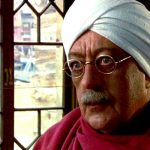
A Passage to India – 1984
This was a small movie that had a very grand feel. What I mean by that is that the story itself was small and intimate, allowing me to really feel close to it. It delved into the minds of the characters, all of whom were real, believable, and well-written. Their motivations were understandable, though complex. The plot was simple and easy to follow. The plot took place over the course of a very short period of time.
But despite the small, personal nature of the plot, the movie had the feel of an epic. It took place in the far and exotic location of India. It took a little time to explore the Indian culture and even gave you a taste of its mysterious, mystical history. The main conflict of the film was, on the surface, between Adela Quested, played by Judy Davis, and Dr. Aziz Ahmed, played by Victor Banerjee, the former accusing the later of rape. But beneath that upper veneer, the conflict was really between the natives of India, and their British oppressors. Throw in the odd choice of casting Sir Alec Guiness in the roll of a native Indian philosopher, Professor Godbole, and English scholar and friend of Dr. Aziz, Richard Fielding, played by James Fox, and you have yourself a movie.
So, here’s the story, as quickly as I can tell it. Adela and her presumptive mother-in-law, Mrs. Moore, played by Peggy Ashcroft, journey to the small provincial town of Chandrapore where Adela is to marry the local magistrate, Ronny Heaslop, played by Nigel Havers. The two women are appalled by the way their British compatriots treat the Indian natives as nothing more than ignorant servants who are practically beneath notice.
They befriend an Indian man, Dr. Aziz, who admires the British for their refined ways and fancy finery. They go on an outing to the Marabar Caves where Adele has some kind of nervous breakdown, which I’ll examine a little more closely in a bit, and accuses Dr. Aziz of attempted rape, though it is made clear to the viewer that he did no such thing. There is a highly publicized trial. The British are scandalized by the audacity of the Indian savage who would dare to assault a proper young British woman. The Indians rally behind the innocent Dr. Aziz.
Fairly early on in the trial, Adele is put on the stand, and after some questioning, she admits that Dr. Aziz is not guilty of the alleged rape. After enduring imprisonment and a ruined reputation, Dr. Aziz is set free, whereupon he is shown to have learned to hate the British and their occupation of his country. He moves away to start a new life in Kashmir, but after several years, and at the encouragement of his old friend, Fielding, he eventually forgives Adele.
The pacing was a little slow for my tastes, and the running time of the movie was 2 hours and 44 minutes. I would have like them to cut about 30 minutes out of the movie, but as I think about it, I don’t know what I would want removed. Everything seemed pretty deliberate and meticulously planned, much like the performances, which were good. They were never over the top and nothing was gratuitous. As a matter of fact, Judy Davis and Peggy Ashcroft both won Oscars for Best Actress and Best Supporting Actress for their performances.
But despite the slow pace, the characters of Adele and Dr. Aziz gave the movie an interesting complexity. It was Adele’s questionable mental stability that kept me engaged. The movie never fully explained why she made up the lie about Dr. Aziz. What happened to her inside the cave that caused her to lose her sanity? Because clearly, after her experience in the caves, she seemed to be on the edge of a kind of madness. I got my biggest clue as to why in an earlier scene, in which Adele is exploring the countryside alone. She discovers the ruins of an ancient Indian temple. Carved into its stone walls are explicit images of men and women copulating in various positions. The images both frightened her and aroused her before she was chased away by a pack of ferocious wild monkeys. She was a woman who was unable to handle her own sexuality. So bad was her claustrophobic breakdown in the cave, her fragile psyche gave her a hallucination which latched onto the kindly Dr. Aziz. Fortunately, her questioning in the trial allowed her to recall the truth. It made her character very interesting, and Davis really did a good job in the roll.








